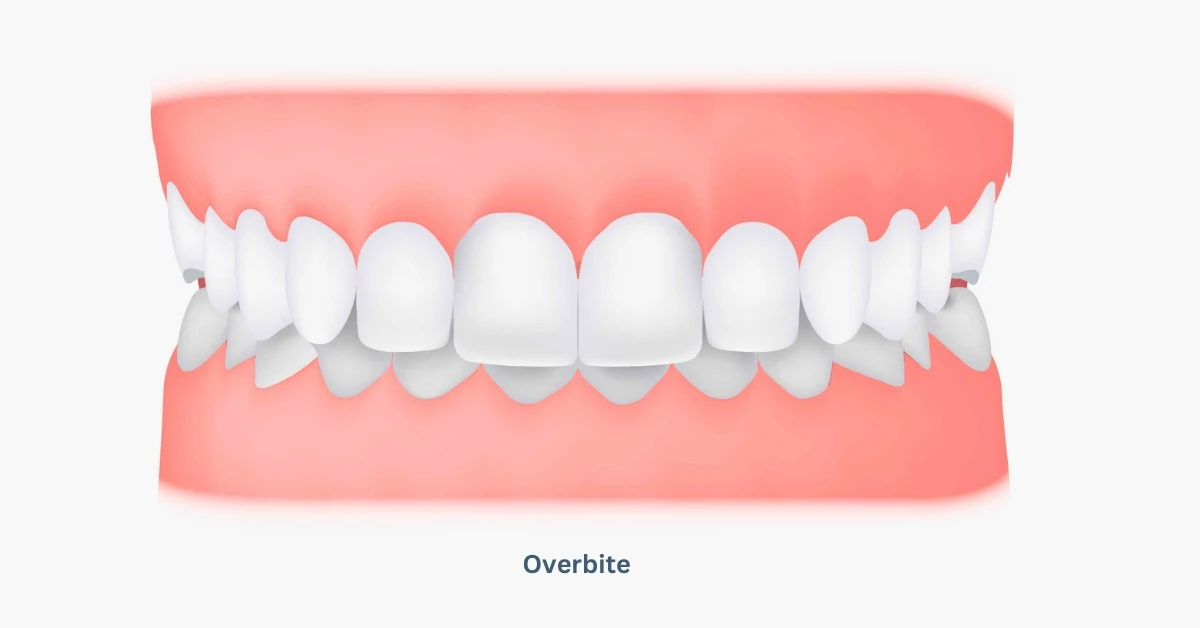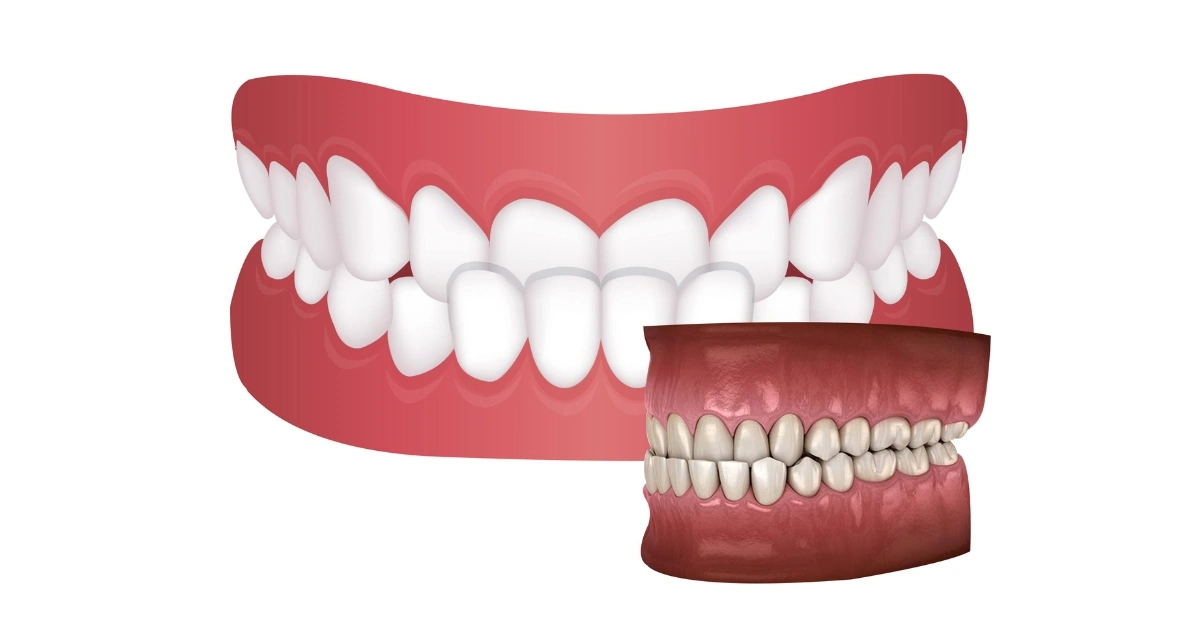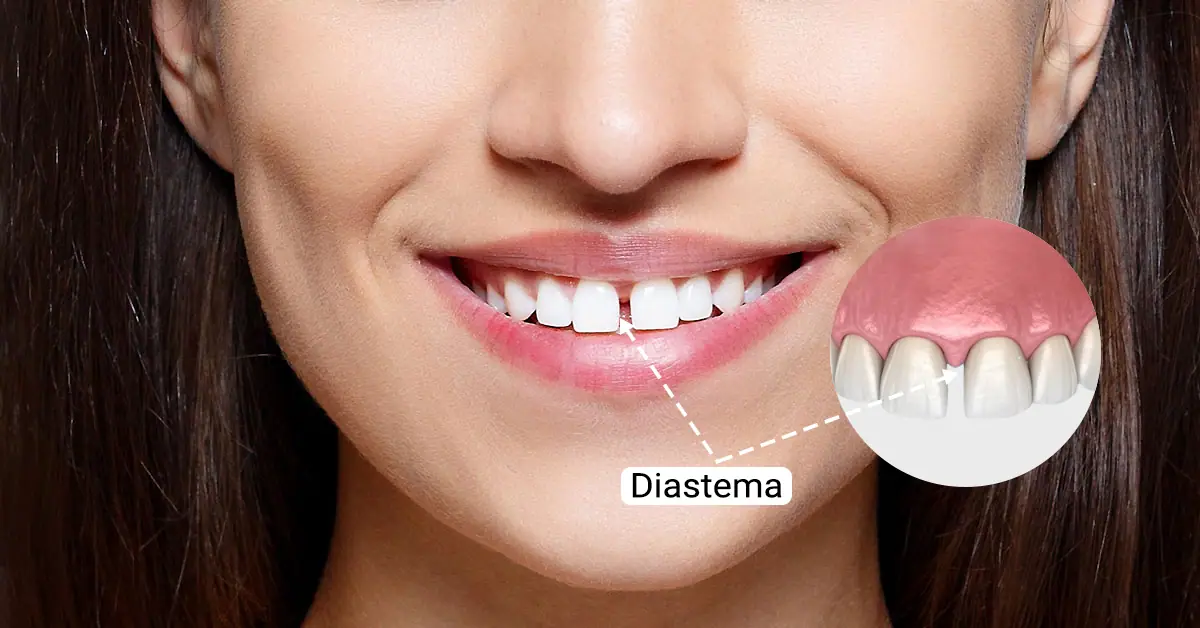Overbite simply refers to vertical misalignment of the teeth when the upper section overlaps the lower section of teeth more than the normal. If left untreated, this can cause several oral issues like jaw pain, tooth erosion, and gum disease.
Understanding Overbite
Overbite is a type of malocclusion ( medical term for misalignment of teeth) which happens when an extensive overlap is seen between the upper and the lower section of teeth. It is also referred to as buck teeth and deep bite.
A small overbite is normal and necessary for proper health and function. But if your upper teeth overlap your lower teeth more than 2 to 4 millimeters, it’s an overbite and could cause jaw pain, headaches, tooth erosion, gum decay, and other oral health conditions.
Types of Overbites
Horizontal overbite:
When the upper front teeth horizontally overlap the lower front teeth, there is an overbite. It means the upper teeth extend past the lower teeth, creating a horizontal gap between the two sets of teeth. Often this type of overbite is caused by habits such as thumb sucking or the use of pacifiers for a prolonged period of time.
Vertical overbite:
When the upper front teeth vertically overlap the lower front teeth, it is known as an overbite. This condition is also named as deep bite. In this case, the upper teeth overlap the lower teeth to a greater extent and more vertically than horizontally. This condition more or less is genetic or caused by misaligned jaw growth.
Its impact on oral health:
Both the types of overbite are effective on oral health in various means like difficulty in chewing food properly or taking a bite. It can lead to potential gum disease and decay. Severe conditions of teeth misalignment may also cause cavity build up due to poor dental hygiene as people with such conditions can not brush or floss properly their teeth. Orthodontic treatment for teeth alignment is highly admired in such cases.

Differentiate between Overbite and Overjet
These two typical types of malocclusions are very much similar to look. As a layman it is hard to differentiate if a person has an overbite or an overjet. The main difference lies in the angle at which the upper teeth sit. Also, an overjet is a horizontal misalignment which is commonly termed as buck teeth, whereas an overbite is a vertical misalignment and also.
It is possible for a person to have both an overjet and an overbite, and in these cases, the overjet is often excessive. While both the conditions are related, they are distinct in their basic structure and require different treatments.
Also Read
Symptoms of Overbite
1. Difficulty biting or chewing:
With an overbite, it is difficult to chew food or even take bites properly due to misaligned teeth. This can lead to bad digestion and gut health.
2. Jaw pain (TMJ):
Overbite can put extra pressure on the jaw or Temporomandibular joints, causing pain and discomfort.
3. Speech problems:
Overbite can affect a person’s speech and make it difficult to articulate or pronounce certain words and sounds properly.
3. Excessive tooth wear:
The lower teeth overlapped by the upper teeth for a long time, easily causing tooth wear and tooth enamel loss.
4. Gum disease:
Above normal, overbite is harmful to even gum health. It can cause potential gum infection and decay.
5. Uneven smile:
Along with oral concerns, patients also experience aesthetic or cosmetic concerns with overbite, as the mouth doesn’t close normally, which leads to uneven smiles.
Causes of Overbite
1. Genetics and hereditary factors:
Overbite can be inherited from parents or grandparents, and certain genes may predispose a person to this condition.
2. Childhood habits:
Childhood habits like thumb sucking, tongue thrusting, and prolonged pacifier usage can lead to a potential overbite.
3. Jaw development irregularities:
Misaligned jaw development can cause the upper and lower jaws to grow in different directions, leading to an overbite.
4. Skeletal growth abnormalities:
An overbite can happen as a mismatch in the shape and size of the jaws and teeth. Mismatched or uneven jaw sizes due to skeletal growth abnormalities can lead to these bite problems.
5. Orthodontic problems:
Orthodontic problems, such as missing or impacted teeth, can cause an overbite.
Diagnosis and Assessment
Diagnosing an overbite usually involves a comprehensive oral examination. This includes an assessment of the bite, tooth position, and jaw alignment to better understand the underlying issues.
Bite analysis:
A bite analysis is a diagnostic tool used to assess the way a person’s upper and lower teeth come together when biting. The dentist or orthodontist observes the patient’s bite and determines if there are any bite issues, such as an overbite or underbite.
Dental X-rays:
This is an essential step for assessing oral health and identifying the root of any dental issues. Dental X-rays can provide detailed images of the teeth, jaw, and surrounding structures, which can help the dentist or orthodontist identify any issues contributing to an overbite.
Orthodontic models:
Orthodontic models are physical replicas of a patient’s teeth and jaws. They can be made from dental impressions and used to study the patient’s bite and determine the best course of treatment.
Panoramic X-rays:
A panoramic is a kind of dental X-ray that provides a broad, detailed view of the patient’s mouth and jaw. This is useful for evaluating the entire jaw and dental arch and can help the doctor identify any issues that cause an overbite.
Patient’s history:
Your doctor may also ask about your medical and dental history and any symptoms you may be experiencing. With this information, they can identify the kind and degree of the overbite and create a treatment strategy.
Treatment Options for Overbite
Age for treatment: An overbite can be treated at any age. However, it is easier to treat in young children because their mouths are still developing. As per the recommendations of dental associations worldwide, the beginning of treatment is ideal between the ages of 8 and 14. Early treatment is beneficial because it can prevent or minimize further complications.
Orthodontic Treatment:
Orthodontic treatment is the most common method to correct overbites. Braces or transparent aligners are used to reposition the teeth to a better position. Depending on the severity of the overbite and the patient’s response to treatment, the course of treatment may last anywhere from six months to two years.
- Metal braces: Traditional metal braces are typically used to cure an overbite. These dental devices use metal brackets and wires to pressure the teeth and slowly move them into the correct position.
- Clear Aligners: Clear aligners are the perfect, new-age solution for orthodontic issues like overbite, overjet, etc. Clear aligners are fabricated with medical-grade plastics that give them a discreet body, are removable, and are very convenient and comfortable for long hours. Similar to traditional braces, these invisible braces are designed to shift the teeth to their desired destination by generating gentle pressure over a period of time.
- Retainers: After the completion of clear aligner treatment, retainers are used to maintain the results.
Jaw Surgery:
Orthognathic surgery, which is surgery of the jaw, corrects irregularities of the jaw bones and realigns the jaws and teeth to improve how they work. It also enhances the facial appearance of a person with severe malocclusion.
Tooth reshaping or recontouring:
Tooth reshaping, or dental contouring, is a cosmetic dental procedure. In this process, small amounts of tooth enamel are removed to change the shape or size of a tooth in situations where teeth are larger, overlapping, or other dental issues with chips or cracks.
Tooth extraction:
In severe cases, tooth extraction can be helpful to get rid of an overcrowded mouth.
Prevention and Management
Importance of early intervention: If you are suffering from overbite or have noticed any symptoms, you should seek a medical consultation as soon as possible. Early intervention can possibly correct any alignment or bite issues of your teeth.
Early Intervention for Childhood Habits: Childhood habits such as thumb sucking and pacifier use should be controlled by the age of 3, as they can take a toll on your kid’s dental health. Similarly, tongue thrusting against teeth, sucking any substance like pen or pencil for a longer period also should be checked.
Proper Oral Hygiene Practices: Maintaining good oral hygiene, such as brushing twice a day, flossing teeth, and using antibacterial mouthwash, is the golden rule to follow if you want to have pearly white teeth!
Regular Dental Check-ups and Cleanings: A lot of people visit a dentist when they have any dental problems. However, dentist visits are also required to prevent those issues. Teeth are very sensitive and prone to catching cavities or tartar very often. So, visit a dentist in 6 months to keep all the dental issues at bay.
Final Verdict
Malocclusion, such as an overbite, is a common dental misalignment, and most people tend to ignore the mild symptoms unless they’re severe.
Many times, you might not even know you have an overbite—when your upper teeth overlap your lower teeth more than they should. If you are experiencing more than normal overlapping along with multiple symptoms, it’s time to visit your dentist.
However, visiting your dentist regularly is advisable. Treating it sooner rather than later can reduce your risk of further issues in case of overbite.
If you seek a consultation with experienced dentists and orthodontists, you have landed at the right place. Contact us for your dental requirements.
FAQs
The symptoms of an overbite, such as jaw pain, difficulty chewing, speech issues, and discomfort when eating, must not be ignored. Visit your nearest dental clinic before an overbite causes severe harm to your dental health and appearance.
You might have an overbite if you can see an abnormal and sharp overlapping (vertical) between your upper and lower section of teeth. Also, symptoms like difficulty chewing, face lisps when uttering some words, jaw pain, and headaches are also indicators of an overbite.
If an overbite is left untreated for a long time, it could cause significant health complications, including irreparable damage to teeth from abnormal positioning, possible jaw pain, and temporomandibular joint disorders (TMJ).
With the right orthodontist and the correct treatments, such as braces and clear aligners, an overbite can be treated in 6 months to 1 year.
Only severe cases of overbites need jaw surgery. In most cases, metal braces and clear aligners can be very helpful in correcting your overbite.
You may get treated for an overbite at any age, but the best-recommended age group is between 8 and 14 years, as in this age group, the gums and jaw are still developing, making it the most favourable condition for a cure.
References:







